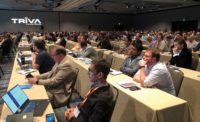In an effort to boost infrastructure project success, Bentley Systems has rolled out several new strategies for improving digital workflows to take projects all the way from concept to operations and even decommissioning, including a new digital twin cloud service dubbed iTwin Services.
Digital twins are virtual replicas of physical assets—such as power plants—that include physical reality captured through scans or photography, and engineering data such as 3D models and as-builts.
“Going digital is at the heart of” eliminating the “waste and inefficiencies” associated with many infrastructure projects, says Adam Klatzkin, senior director for Bentley’s iModel technologies.
Speaking at Bentley’s Year in Infrastructure conference in London Oct. 15-18, Klatzkin explained that part of the challenge with creating digital twins of complex projects is that they must incorporate vast amounts of data from many different sources and tools.
“There is no single application or data format that exists today that can be the digital twin,” he says. “Just as every physical asset must have a solid foundation, so must its digital twin.” Bentley’s iTwin Services, available in early 2019, aims to provide that foundation by “bringing together iModelHub, reality modeling and web visibility within a connected data environment, creating the platform for the world’s infrastructure digital twins,” Klatzkin says.
One test user of iTwin Services, Michael Gaunt, information manager at Mott MacDonald, said that the product helps the team on the U.K.’s 330-mile-long HS2 high-speed rail project make “more informed decisions, implement more intelligent validation procedures, ensure consistency—because we know exactly what our design is made up from—better identify design efficiencies and design for manufacturing assembly.”
Evolving a digital twin with its sibling is another challenge, and in what Bentley founder and chief technology officer Keith Bentley called “a watershed moment” in the firm’s 34-year history, the software company has released an open-source library using the same JavaScript source code “that Bentley uses to create our own tools and products.”
The iModel.js library, available at imodeljs.org and via GitHub, will let users create web-based, immersive visualizations of digital twins in what Bentley hopes will become a thriving, open-source ecosystem of web, mobile and desktop applications.
“I think it’s going to be the future,” Bentley says. “I don’t know if it’s going to be from Bentley or someone else, but I can tell you the winning solution for digital twins will be an open system—the more open the better.” The company has pledged significant investment to create the open-source ecosystem, he adds.
Peter Vale, engineering information manager for Tideway, London’s 16-mile-long combined stormwater and sewer tunnel project, noted, however, that while open-source use of digital twins is “the way forward, the reality is it’s very centric to design and construction,” he says. “When we start talking about the operational side and you have organizations that have legacy systems, they don’t have open source.”
To address that issue, Bentley announced PlantSight, a collaboration with Siemens to “make the entire data environment much more rich and consistent” and provide digital twins that boost plant performance and operations, says Horst Kayser, Siemens’ chief strategy officer. Siemens is a 9% shareholder in Bentley and announced a €100-million joint investment to drive development of integration tools, including PlantSight.
“The focus is combining the 2D and 3D plant design and engineering data with the enterprise data to get a more holistic and realistic view of the physical reality in the digital twins [and] to be able to work and optimize in the virtual world,” Kayser says.





Post a comment to this article
Report Abusive Comment